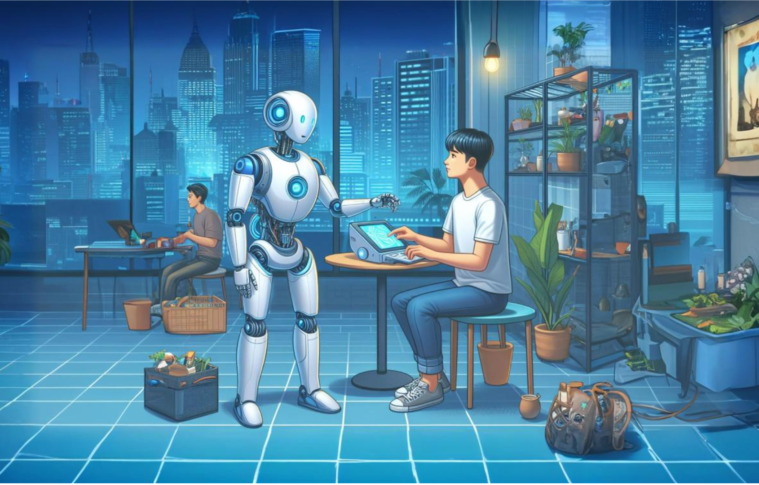In the evolving world of technology, terms like Human-Computer Interaction (HCI) and Artificial Intelligence (AI) are often mentioned together. While they are interconnected in many ways, they represent distinct fields with unique goals and methodologies. This blog explores the differences between HCI and AI, their individual purposes, and how they complement each other to shape the future of technology.
What is Human-Computer Interaction (HCI)?
HCI is the study and practice of designing systems and interfaces that enable effective communication and interaction between humans and computers. It focuses on:
- Usability: Making systems intuitive and easy to use.
- User Experience (UX): Enhancing user satisfaction.
- Accessibility: Designing for diverse user needs and abilities.
HCI involves fields like psychology, design, and ergonomics to ensure technology aligns with human needs. For example, designing a smartphone interface or creating user-friendly dashboards falls under HCI.
What is Artificial Intelligence (AI)?
AI refers to the development of systems that can perform tasks that typically require human intelligence. These tasks include:
- Learning: Using data to improve performance over time.
- Reasoning: Solving problems or making decisions.
- Natural Language Processing (NLP): Understanding and generating human language.
- Computer Vision: Interpreting visual data.
AI powers applications like recommendation systems, autonomous vehicles, and virtual assistants (e.g., Siri or Alexa).
Key Differences Between HCI and AI
| Aspect | HCI | AI |
|---|---|---|
| Focus | Improving the interaction between humans and computers. | Enabling machines to mimic human intelligence. |
| Core Objective | Enhancing usability and user experience. | Automating and optimizing tasks. |
| Approach | Human-centered design principles. | Data-driven and algorithm-based systems. |
| Primary Tools | Design frameworks, usability testing, and prototyping. | Machine learning models, neural networks, and big data. |
| Scope | User interfaces, interaction design, and accessibility. | Decision-making, automation, and predictive analytics. |
How Do HCI and AI Work Together?
Although they are distinct, HCI and AI often intersect to create more powerful and intuitive systems. Here’s how they complement each other:
- Enhancing User Interfaces with AI
- AI can analyze user behavior to create personalized experiences, which HCI designs into interfaces.
- Example: Netflix uses AI for recommendations, while HCI ensures the interface is intuitive for browsing.
- Voice and Gesture Interfaces
- HCI focuses on making interfaces like voice commands user-friendly, while AI powers natural language understanding.
- Example: Virtual assistants like Alexa are designed using HCI principles but rely on AI for functionality.
- Predictive Design
- AI can anticipate user needs, and HCI ensures that these predictions are delivered in an understandable and actionable way.
- Accessibility Solutions
- AI-driven tools, such as real-time text-to-speech for visually impaired users, are made accessible through HCI.
Challenges in Combining HCI and AI
- Balancing Control and Automation
- AI systems often make decisions autonomously, which may conflict with HCI’s goal of keeping users in control.
- Transparency
- AI systems can be complex and opaque. HCI must ensure users understand how and why AI makes decisions.
- Bias in AI Models
- HCI practitioners must work to minimize the impact of biased AI outcomes on user experience.
- Adaptability
- AI evolves rapidly, and HCI designs need to keep up to ensure interfaces remain relevant.
Future of HCI and AI Integration
The synergy between HCI and AI is reshaping technology:
- Emotion-Aware Systems: AI can detect user emotions, while HCI ensures these insights are applied meaningfully, such as in mental health apps.
- Adaptive Interfaces: AI-driven interfaces that adjust dynamically to user needs are becoming more common.
- Augmented Reality (AR) and Virtual Reality (VR): HCI designs immersive experiences while AI powers object recognition and interaction.
Conclusion
HCI and AI are distinct but interconnected fields. While HCI focuses on creating user-centered designs, AI aims to bring intelligence and automation to systems. Together, they push the boundaries of innovation, ensuring technology is not only powerful but also accessible, intuitive, and human-centric.
Understanding the differences and synergies between HCI and AI is essential for anyone involved in designing or developing the next generation of technological solutions.
Disclaimer
Posts in the Notebook are written by individual members and reflect personal insights or opinions. Please verify any information independently. If you have any concerns, notify the admin immediately so we can take action before any legal steps are taken.





